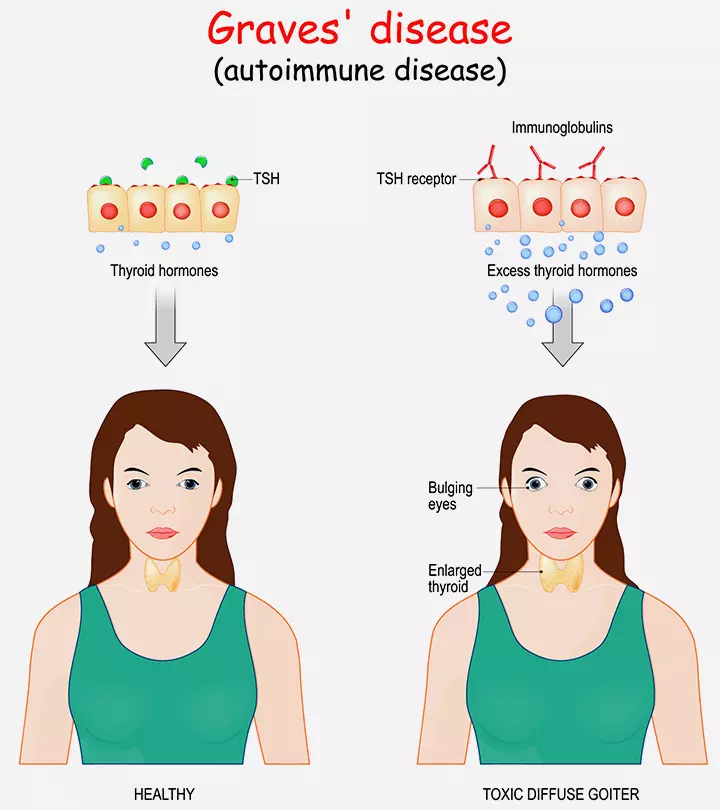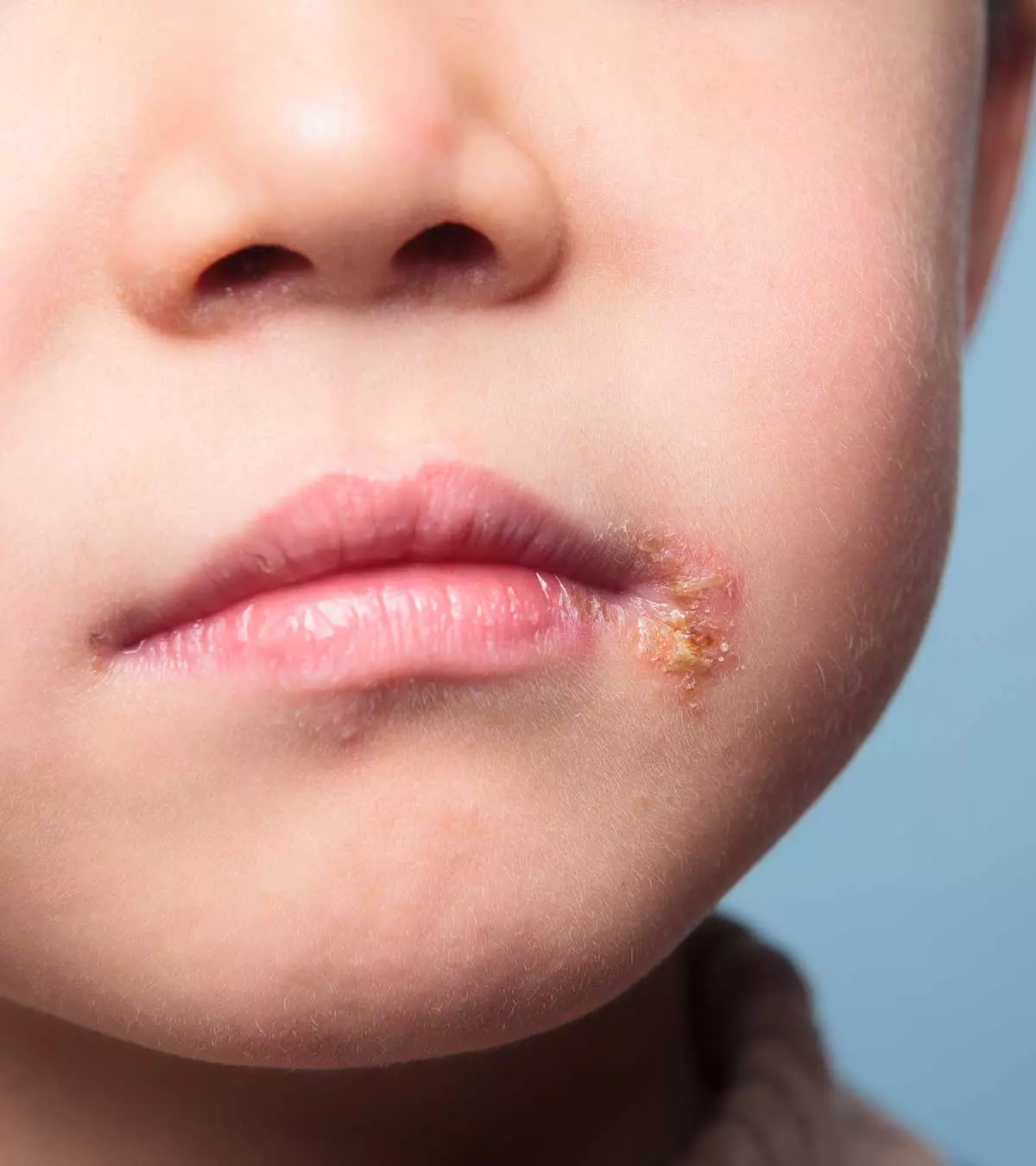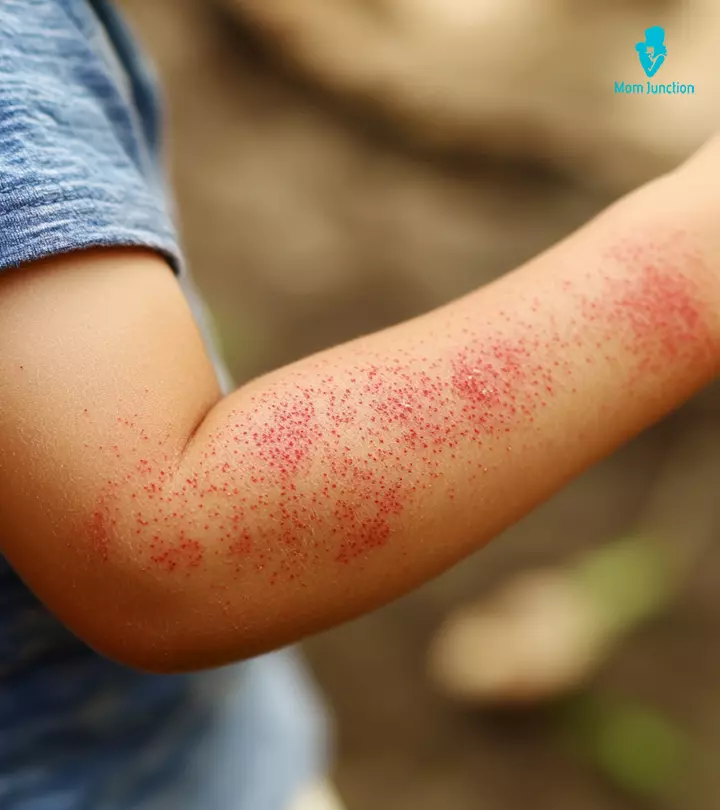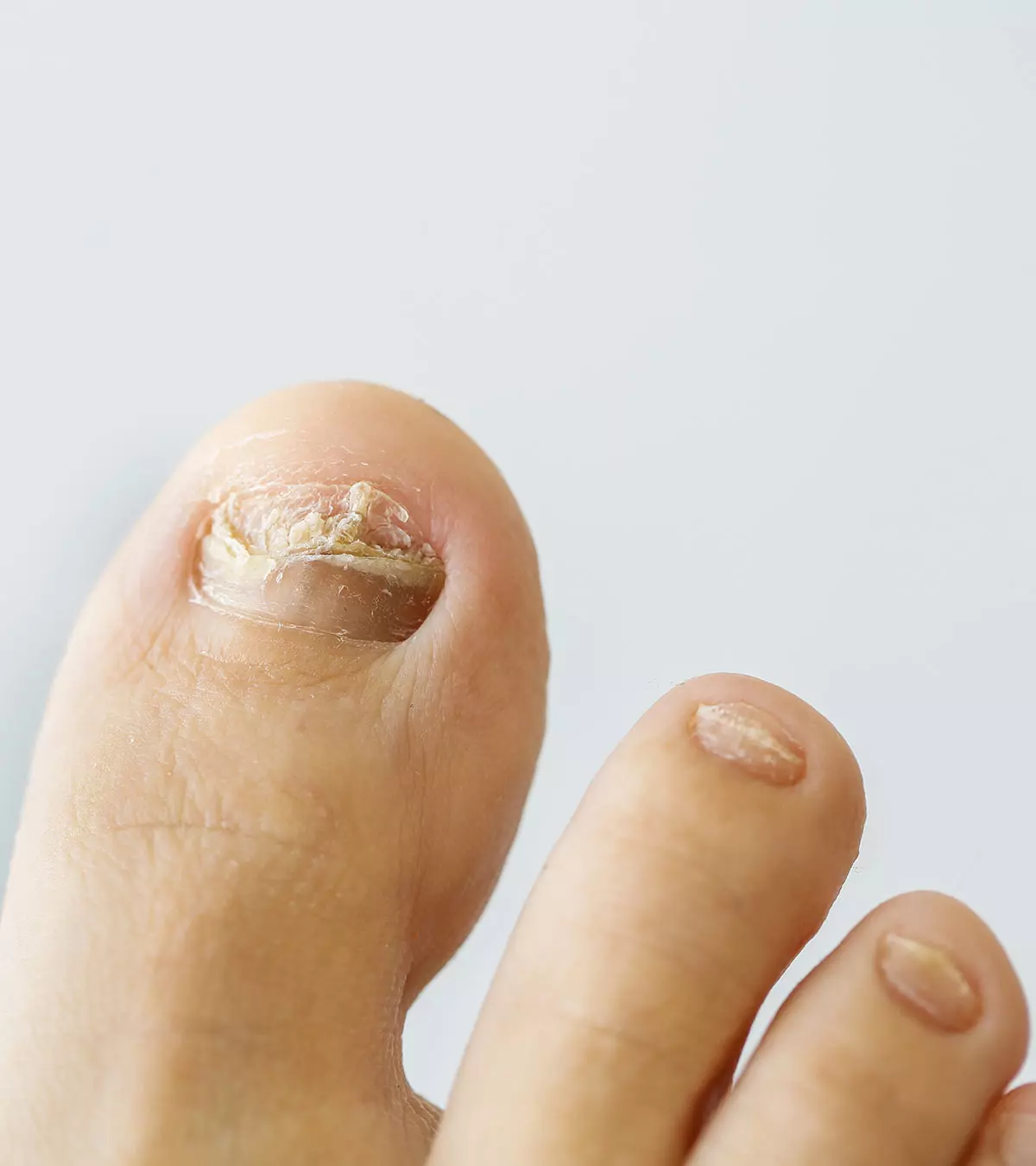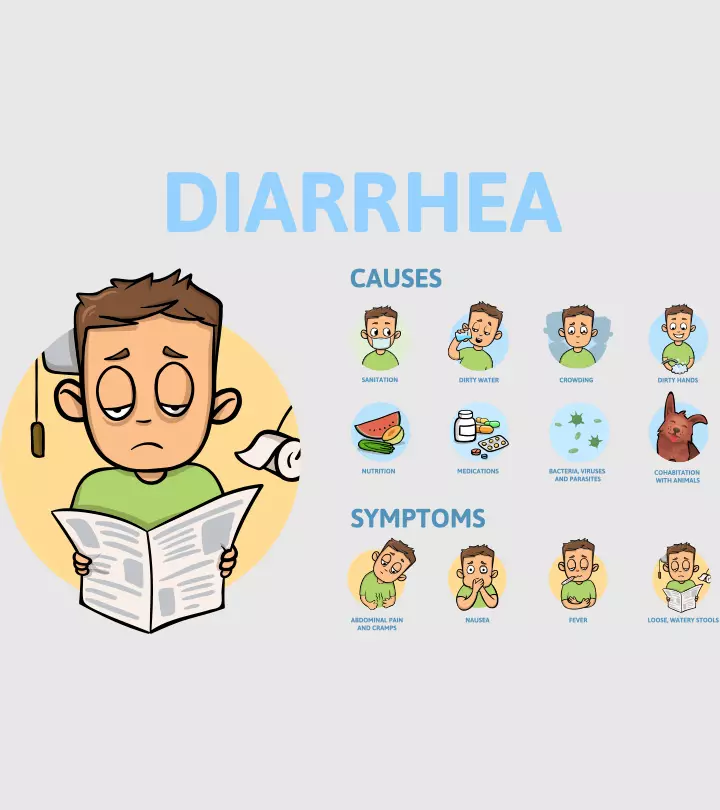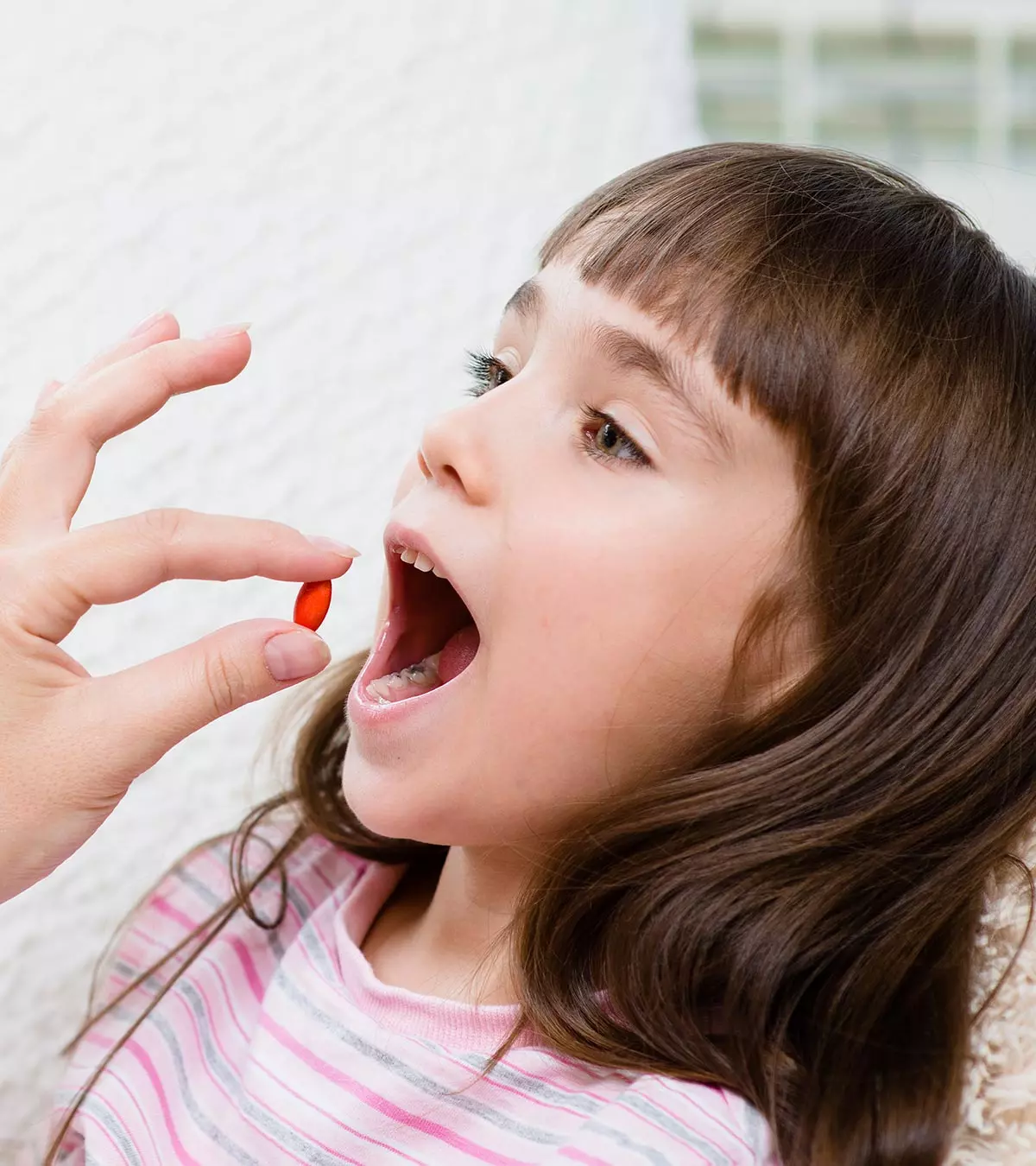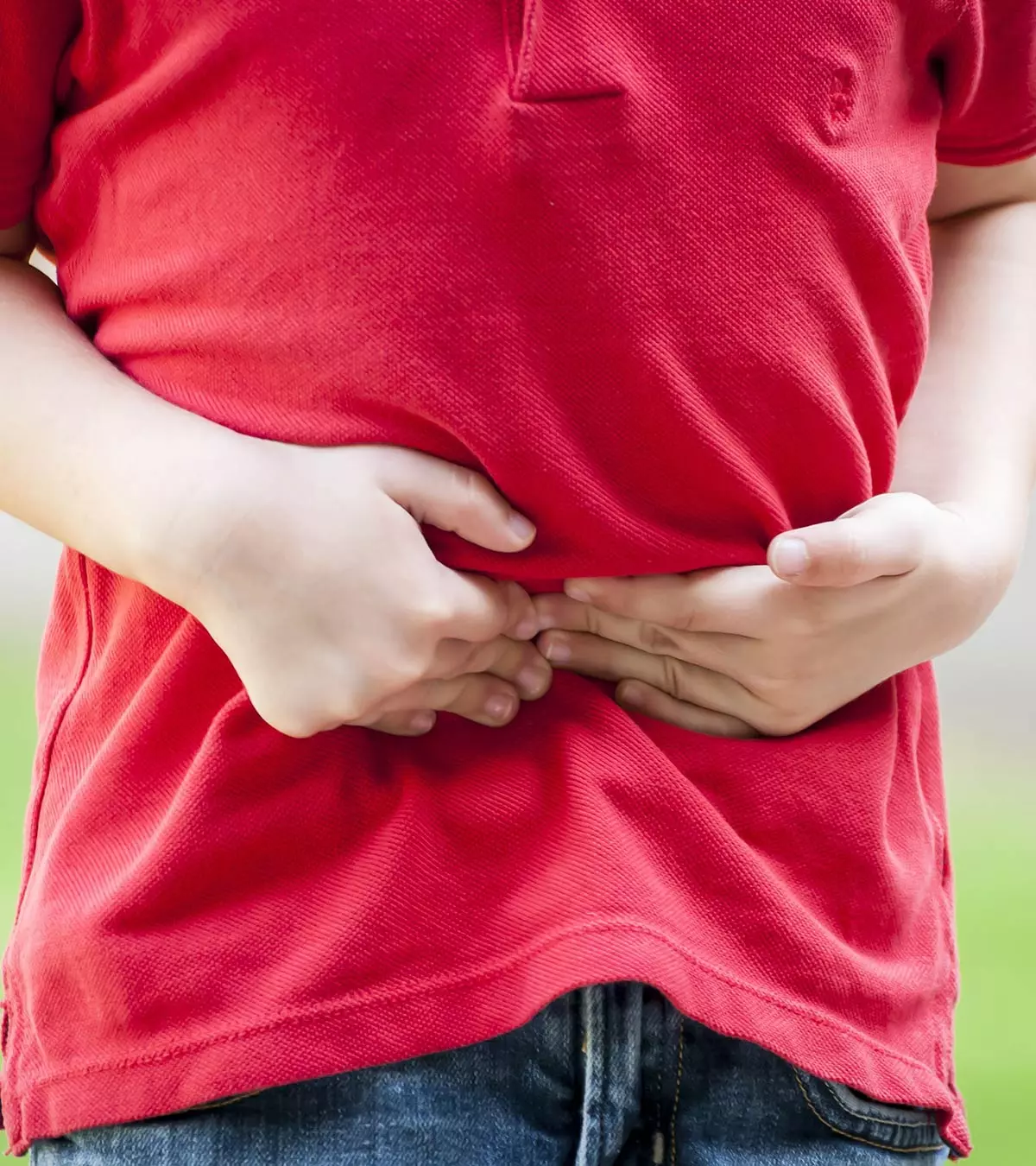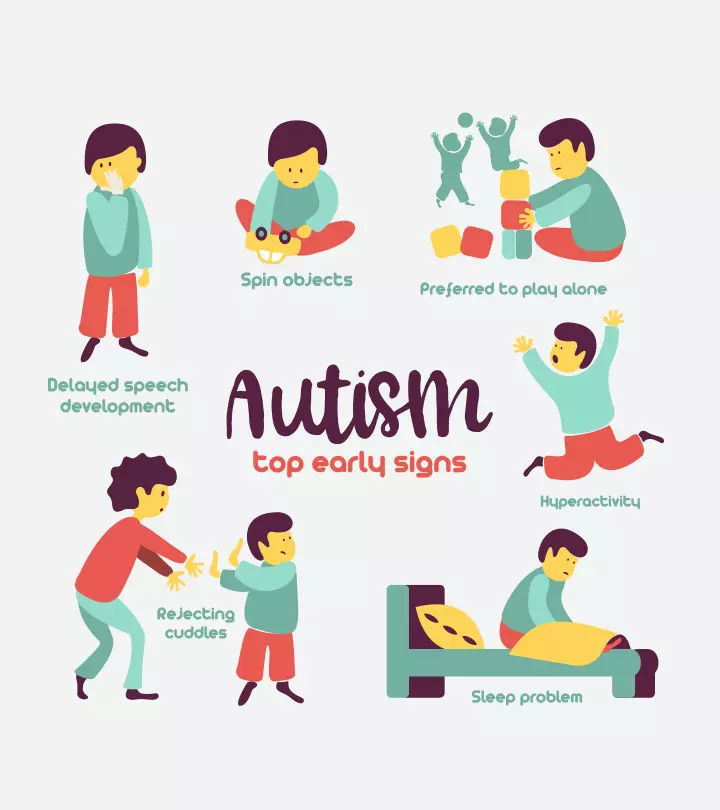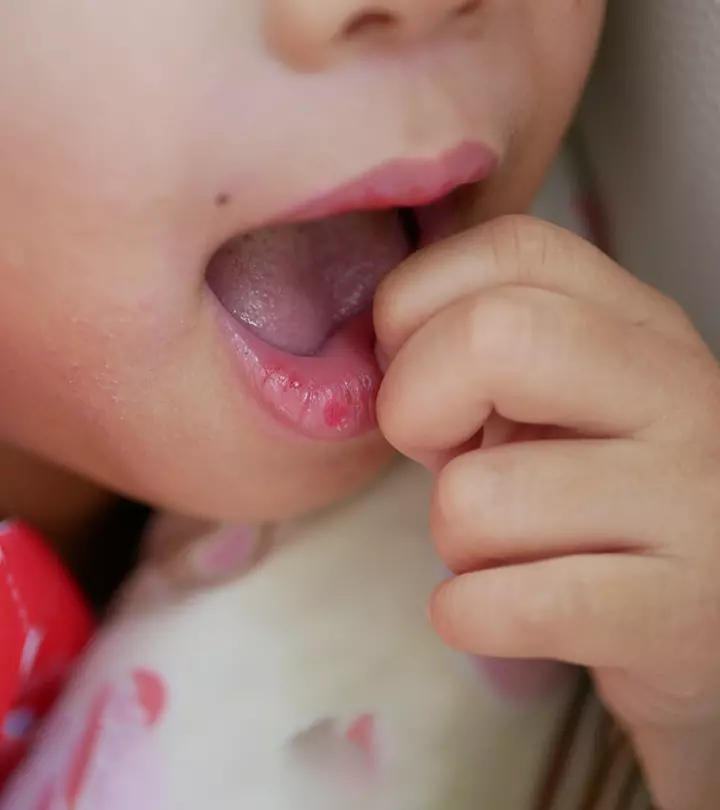
Image: Shutterstock
Skin picking in children is a repetitive behavior characterized by picking the skin. It is most common in teenagers and children below ten years. While for most people, it is a rare instance, for others, it might become a habit that can turn into a skin picking disorder. Frequent skin picking can cause skin lesionsiAn abnormal change or damage to the tissues caused by an injury or a disease (1) (2).
In a multi-institute case-control study examining patients with excoriation disorder, it was found that they exhibited 28.48 times higher odds of Obsessive-Compulsive Disorder (OCD).
Read on to know the causes, symptoms, effects, and treatments for skin picking in children.
Key Pointers
- Constant skin picking that causes lesions, stress, or disruption may indicate that the child has skin picking disorder.
- The condition is often seen in children with depression, anxiety, or OCD. It may also indicate anemia, uremia, or liver diseases.
- The habit may lead to bleeding, bruising, sores, or permanent disfiguration of skin.
- The disorder may be treated using barriers such as band-aids, cognitive behavior therapy, antidepressants, etc.
Signs Of Skin Picking Disorder

Image: Shutterstock
As per the criteria set by the Diagnostic and Statistical Manual of Mental Disorders, Fifth Edition (DSM-5), the following signs and symptoms could confirm a diagnosis of skin picking disorder in children (3).
- Recurrent skin picking resulting in lesions
- Repeated attempts at changing the behavior
- Skin picking that causes significant stress, adversely affects one’s mental health or impairment to one’s daily life
- Skin picking that is not associated with the effects of a medication or medical condition such as scabies
- Symptoms are not linked to a psychiatric condition
 Quick fact
Quick factDiagnosis Of Skin Picking In Children
If the general doctor suspects skin picking disorder in your child, they may refer them to a mental health professional, who will examine your child’s behavior and take a thorough history. This evaluation can help make an accurate diagnosis, identify any psychiatric conditions, and rule out similar conditions (4).
Causes Of Skin Picking In Children
The exact cause of skin picking in children is not known. However, research suggests that skin picking is more prevalent in individuals with OCD, and their immediate family may be genetically predisposed to this condition (1).
Major depression and anxiety disorders are the other most common psychiatric disorders that coexist with skin picking. Besides, anemiaiA condition where the body has low levels of healthy blood cells or hemoglobin , uremiaiA serious kidney disorder where waste and toxins from urine accumulate in the blood , or liver diseases may also cause behavioral disorders, such as skin picking.
In some cases, certain stressful events or situations may trigger skin-picking episodes in children. In contrast, a few children might indulge in skin picking as they associate it with feelings of relief or pleasure (5).
Dr. Jared Heathman, a board-certified psychiatrist from Cypress, Texas, says, “Anxiety can cause skin picking due to the link between stress and the development or worsening of the behavior. Therefore, when a person is anxious, they may be more likely to engage in repetitive behaviors such as skin picking to cope with their stress or anxiety. Additionally, skin picking can become a habit or compulsive behavior used to manage their anxiety, even if it ultimately worsens the anxiety in the long run.”
Manifestations Of Skin Picking Disorder
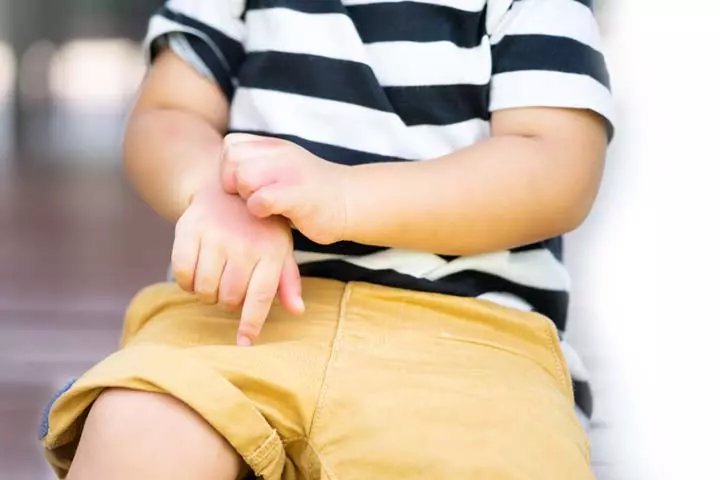
Image: Shutterstock
How and where people pick their skin may differ from person to person. The face, head, cuticles, back, arms, legs, hands, and feet are the most common areas people pick their skin. Some children might pick their skin with their nails and fingers, while others might use scissors and tweezers or resort to biting (6).
Effects Of Skin Picking Disorder

Image: Shutterstock
The effects of compulsive skin picking in children can range from mild to extreme. Some children might pick the skin from scabsiA hard protective layer of dried blood that forms over a wound on the skin or a rash, which can worsen the wound and cause bleeding, bruising, and secondary infections. In severe cases, the itching may lead to wounds or sores that warrant hospitalization or even surgical correction (5). Teens usually pick their acne lesions/pimples, which worsens the severity and can lead to scarring.
Compulsive behavior like skin picking can also lead to alteration to one’s appearance and cause a feeling of shame. Teens with permanently disfigured skin may resort to wearing clothes that cover their wounds or using makeup to hide their scars. In some extreme cases, they may isolate themselves and avoid social situations (5). They might have difficulty making friends and bonding with others. Therefore, awareness of possible social dysfunction is important among parents and caregivers.
Treatments For Skin Picking Disorder In Children
The treatment for skin picking disorder depends on the child’s motivation and readiness to address the problem. One or more of the following treatments could be followed (2).
- Placing barriers
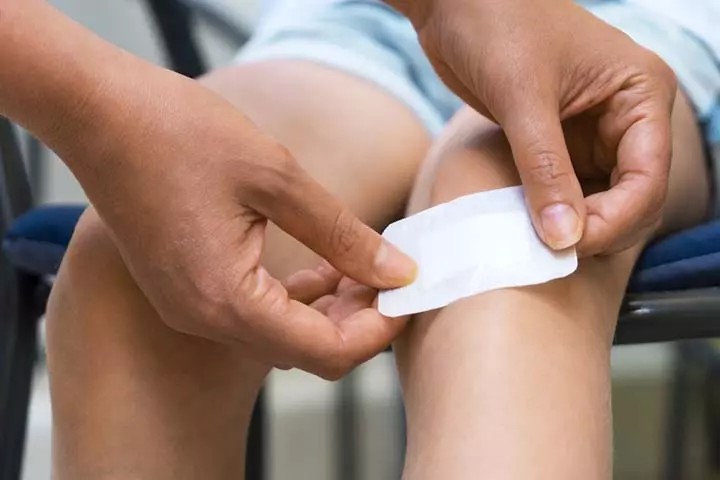
Image: Shutterstock
- Using a band-aid can help prevent the child from picking the skin to an extent. You could also use a paint-on liquid bandage, which can help distract the child when they feel the urge to pick their skin.
- Although this approach may not help eliminate the habit, it can act as habit reversal training and prevent the child from acting impulsively.
 Quick tip
Quick tip- Cognitive behavior therapy (CBT)
- It is the most successful treatment for skin picking.
- Cognitive behavioral therapy mainly focuses on teaching the child more effective ways to deal with stress and anxiety.
- It helps children find similar but less damaging behaviors to focus on.
- NAC (N-acetyl-cystine)
- It is an over-the-counter ointment that can be effective on some children.
- It is a safe option as it is devoid of side effects.
- Antidepressants
- If the skin picking habit is triggered by anxiety and depression, selective serotonin reuptake inhibitors (SSRIs), a type of antidepressant, can effectively help manage the condition.
- Acceptance and commitment therapy (ACT)
- This therapy is a combination of CBT and mindfulness techniques.
- It focuses on accepting emotions instead of suppressing them or resorting to coping mechanisms such as skin picking. You may also resort to support groups and family therapy to help the child.
- It helps in training the child to accept that they may experience negative emotions, and when they do, they need not succumb to self-destructive habits.
Frequently Asked Questions
1. Can skin picking disorder in children be cured?
To cure skin picking disorder in children, you must identify the triggers. Then, help them find ways to avoid or control the triggers with the help of relaxation techniques or distraction techniques. You may also seek a therapist’s assistance, who may help your child manage their feelings. Usually, medications are not prescribed to cure this disorder (7).
2. What helps skin-picking wounds heal faster in children?
To help skin-picking wounds heal faster, clean the wound with mild soap and water. Apply the prescribed ointments or petroleum jelly on the areas frequently. Cover the areas with a bandage and change the band-aid if it gets dirty. Trim your child’s nails frequently to avoid any sharp cuts on their skin.
3. When should I see a doctor about skin picking?
If you notice that your child picks on their skin compulsively, causing self-harm and cannot control it, seek a doctor’s help. You should also consult a doctor if you notice any infection near the skin-picking wounds.
4. Is skin picking related to ADHD?
Elisa Nebolsine, cognitive behavioral therapist and specialist from Alexandria, Virginia, says, “Research does not establish a clear link between the two, but some research has hinted at a potential association. ADHD is characterized by impulsiveness, lack of focus, and restlessness, which may cause individuals with ADHD to be more likely to engage in repetitive behaviors like skin picking.”
5. How can parents help manage skin picking in children?
If you see skin picking in your child, take note of its occurrence and the triggering factors. Help them with some strategies, such as distraction, and if necessary, seek professional help. Help, support, and encourage them throughout their treatment plan.
6. What are the long-term effects of skin picking in children?
If left untreated, skin-picking behaviors in children can subsequently cause chronic illnesses and psychosocial dysfunction, which could manifest through poor social skills or isolation. Frequent skin picking can also lead to sepsis in some cases (4).
If you notice your child picking their skin, start by telling them not to do it. If the habit persists, you could use barriers such as band-aids that will help them stop picking. Do not try to force stop your child from picking as it might take things the other way. The management of signs will be easier if your child understands the issue and wants to manage the disorder. If you have any questions or concerns regarding the same, consult a medical professional or a pediatric skin specialist for proper guidance.
Infographic: Home Management Tips For Skin Picking In Children
Skin picking may be occasional or a habit, but it should be stopped to avoid scars and prevent it from becoming a disorder. So if your child picks their skin often, note some dos and don’ts from this infographic. These simple yet effective practices may help them overcome and resist the urge to pick. Illustration: Momjunction Design Team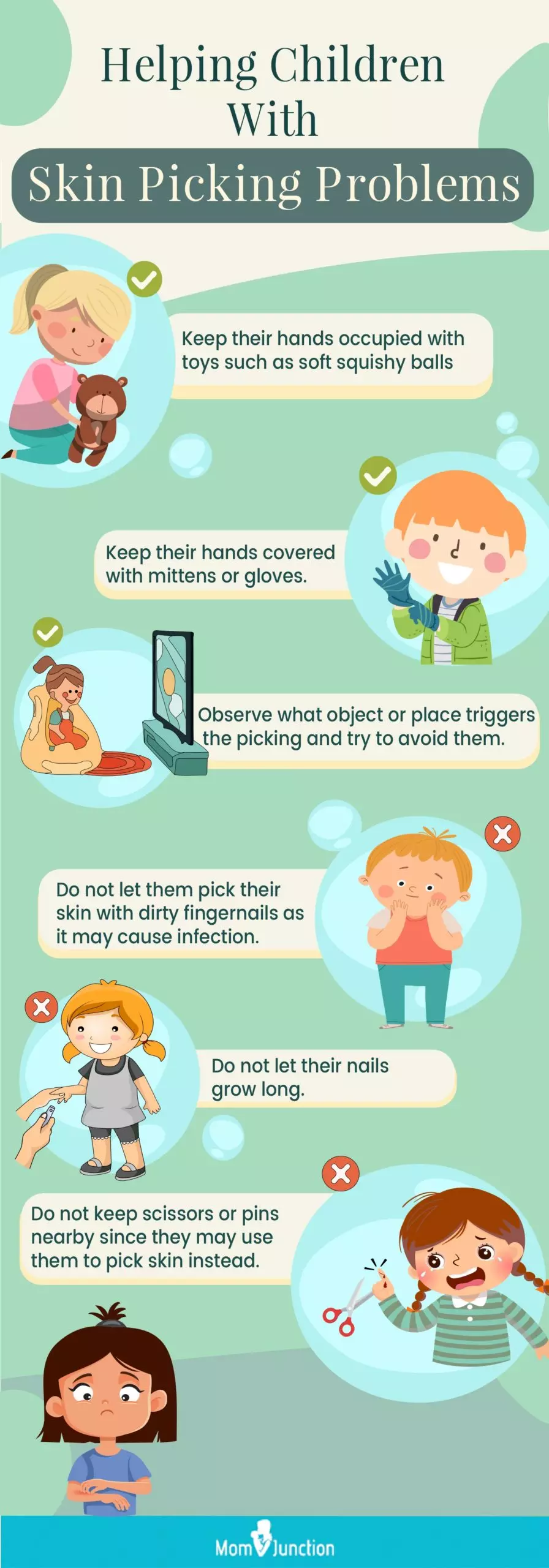
Illustration: Treatments For Skin Picking In Children Signs And Causes

Image: Stable Diffusion/MomJunction Design Team
Help your child stop body-repetitive behaviors like hair pulling and skin picking. Learn how to support your child in overcoming these habits.
References
- Excoriation Disorder (Skin Picking Or Dermatillomania).
https://mhanational.org/conditions/excoriation-disorder-skin-picking-or-dermatillomania - What Is Excoriation, or Skin-Picking?
https://childmind.org/article/excoriation-or-skin-picking/ - Impact of the DSM-IV to DSM-5 Changes on the National Survey on Drug Use and Health [Internet].
https://www.ncbi.nlm.nih.gov/books/NBK519704/table/ch3.t28/ - Jon E. Grant and Samuel R. Chamberlain; Trichotillomania and Skin-Picking Disorder: An Update; NCBI
https://www.ncbi.nlm.nih.gov/pmc/articles/PMC9063575/ - Compulsive skin picking.
https://dermnetnz.org/topics/compulsive-skin-picking - What is Skin Picking Disorder?
https://iocdf.org/about-ocd/related-disorders/skin-picking-disorder/ - A Quick Guide to Exorciation Disorder;
https://childmind.org/guide/quick-guide-to-excoriation-disorder/# - Skin picking disorder
https://www.nhs.uk/mental-health/conditions/skin-picking-disorder/
Community Experiences
Join the conversation and become a part of our nurturing community! Share your stories, experiences, and insights to connect with fellow parents.
Read full bio of Dr. Deepak Jakhar
- Dr. Jared Heathman graduated from medical school at Texas Tech University Health Sciences Center and trained in child psychiatry and adult psychiatry at the University of Texas Medical Branch. He currently practices in Houston. Dr. Heathman has presented lectures on post-concussion syndrome, childhood depression, psychopharmacology (medications), ADHD, and personality disorders.
 Dr. Jared Heathman graduated from medical school at Texas Tech University Health Sciences Center and trained in child psychiatry and adult psychiatry at the University of Texas Medical Branch. He currently practices in Houston. Dr. Heathman has presented lectures on post-concussion syndrome, childhood depression, psychopharmacology (medications), ADHD, and personality disorders.
Dr. Jared Heathman graduated from medical school at Texas Tech University Health Sciences Center and trained in child psychiatry and adult psychiatry at the University of Texas Medical Branch. He currently practices in Houston. Dr. Heathman has presented lectures on post-concussion syndrome, childhood depression, psychopharmacology (medications), ADHD, and personality disorders. - Elisa Nebolsine is a therapist, author, and CBT specialist. Her therapy practice is based in Alexandria, Virginia, and is licensed in VA, MD, NY, MA, and DC. Elisa holds a masters degree in Clinical Social Work from Smith College.
 Elisa Nebolsine is a therapist, author, and CBT specialist. Her therapy practice is based in Alexandria, Virginia, and is licensed in VA, MD, NY, MA, and DC. Elisa holds a masters degree in Clinical Social Work from Smith College.
Elisa Nebolsine is a therapist, author, and CBT specialist. Her therapy practice is based in Alexandria, Virginia, and is licensed in VA, MD, NY, MA, and DC. Elisa holds a masters degree in Clinical Social Work from Smith College.
Read full bio of Dr. Ritika Shah
Read full bio of Rebecca Malachi
Read full bio of Vidya Tadapatri












